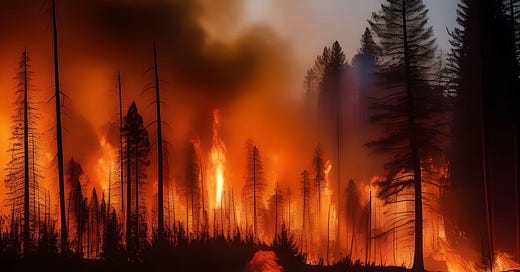Wildfires, a terrifying yet natural phenomenon, pose a constant threat to lives, property, and ecosystems. While complete prevention might be elusive, the ability to predict wildfires has become a crucial tool in mitigating their devastation. As climate change and land-use pressures contribute to more frequent wildfire events, the ability to forecast and prepare for these incidents is proving invaluable for forest management and public safety.
Advancements in Wildfire Prediction
Recent developments in machine learning and artificial intelligence have significantly enhanced our ability to predict wildfire occurrence and behaviour. These technological advancements offer several key benefits:
Improved Accuracy: Machine learning models can process vast amounts of data from diverse sources, including meteorological conditions, vegetation characteristics, and human-related factors. This comprehensive approach allows for more precise predictions of wildfire danger compared to traditional methods.
Early Warning Systems: AI-powered prediction tools can provide forecasts up to ten days in advance, giving authorities and communities crucial time to prepare and implement preventive measures.
High-Resolution Forecasting: New tools like the Probability of Fire (PoF) model can generate global forecasts at a 1 km resolution, offering detailed insights into localized fire risks.
Cost-Effective Solutions: Machine learning models are often computationally cheaper to run than traditional physical models, making them more accessible for widespread use.
Wildfires, a terrifying yet natural phenomenon, pose a constant threat to lives, property, and ecosystems. While complete prevention might be elusive, the ability to predict wildfires has become a crucial tool in mitigating their devastation. The ability to predict wildfires more accurately and with greater lead time has several practical applications in wildfire management:
Risk Assessment: Prediction tools help identify areas at higher risk of wildfires, allowing forest managers to prioritize resources and implement targeted prevention strategies.
Resource Allocation and Deployment: With better forecasts, fire management agencies can strategically position personnel and equipment in high-risk areas before fires occur. Knowing areas at high risk allows for pre-deployment of firefighters, equipment, and logistical support. This swift response can significantly reduce the window for fire spread and damage
Evacuation Planning: Advanced warning of potential fire events enables authorities to develop and execute evacuation plans more effectively, potentially saving lives and allowing residents to secure their belongings.
Fuel Management: Predictive models can inform decisions about vegetation management, such as controlled burns or creating firebreaks in high-risk areas. Controlled burns in low-risk periods can reduce fuel loads and create firebreaks, hindering the spread of future wildfires. However, acknowledging the limitations of prediction models and fostering public awareness is essential for a well-rounded wildfire management strategy.
Public Awareness: Accurate predictions allow for timely public communications, increasing awareness and preparedness among communities in fire-prone regions.

Limitations and Challenges
While wildfire prediction has proven highly useful, it's important to acknowledge its limitations: prediction is not foolproof. Wildfire behavior can be unpredictable, influenced by unforeseen weather changes or variations in topography and fuel loads. This uncertainty can lead to:
Resource Misallocation: Overly cautious predictions could lead to unnecessary resource deployment, straining budgets and hampering response times to actual emergencies.
Public Complacency: Conversely, inaccurate low-risk predictions might lull the public into a false sense of security, hindering preparedness efforts.
Data Quality: The accuracy of predictions relies heavily on the quality and availability of input data, including satellite observations and land cover information.
Human Factors: Predicting human-caused ignitions, which account for 90% of wildfires, remains challenging due to the unpredictable nature of human behaviour.
Model Adaptability: Existing models may need further refinement to accurately assess fire risk across diverse ecosystems and landscapes.
Interpretation and Action: Translating predictions into effective management actions requires expertise and coordination among various stakeholders.
To maximize the effectiveness of predictions, a multifaceted approach is necessary. Continuous improvement in prediction models, combined with ongoing public education and preparedness initiatives, is crucial.
Future Prospects
The field of wildfire prediction continues to evolve, with promising developments on the horizon:
Integration of Multiple Data Sources: Combining data from various satellites and sensors is expected to improve prediction accuracy and coverage.
Real-Time Monitoring: AI-powered systems linked to imaging satellites and software-defined cameras offer the potential for near-real-time fire detection and monitoring.
Ethical Considerations: As AI becomes more prevalent in wildfire management, addressing ethical and regulatory considerations will be crucial.
In conclusion, prediction plays a vital role in modern wildfire management. By providing accurate, timely, and detailed forecasts, these tools enable proactive strategies that can significantly reduce the impact of wildfires on ecosystems, property, and human lives. As technology continues to advance, the integration of AI and machine learning in wildfire prediction and management is likely to become even more valuable in our efforts to build wildfire resilience and protect our forests. However, acknowledging the limitations of prediction models and fostering public awareness is essential for a well-rounded wildfire management strategy.
References:
Predicting Wildfires: Techniques and Tools for Monitoring and Mitigating Risk [BlueSky Analytics "Predicting Wildfires: Techniques and Tools for Monitoring and Mitigating Risk"]
NFDRS - U.S. National Fire Danger Rating System
National Fire Danger Rating System (NFDRS) Explained | WFCA
Mixed Integer Programming Models for Fire Fighting - Filipe Alvelos
Developing effective wildfire risk mitigation plans for the wildland urban interface – Alan T. Murray et al
WRF Model - Weather Research and Forecasting model
Weather Research & Forecasting Model (WRF) | Mesoscale & Microscale Meteorology (ucar.edu)
FARSITE - Fire Area Simulator - Mark A. Finney
FARSITE: Fire Area Simulator-model development and evaluation (usda.gov)







